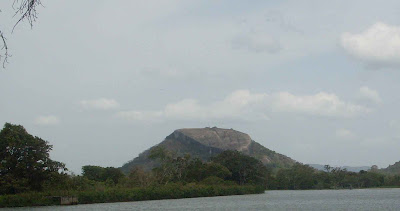Sigiriya - what is it? A 'Garden of Eden', ancient resort, or just a pyramid on the top of a rock? Machine processing of granite stone and other evidences of advanced ancient technologies.
In this essay, I outline my impressions, based on facts and observations – including observations of some things that are unexplained in terms of what we are familiar with in the 21st Century. As these are simply my impressions, I would appreciate comments (and, perhaps answers) to any questions my own comments and observations give rise to. My visit to Lion's Rock made me realize that this place is more mysterious than commonly known, and worth more serious attention than I ever expected. So, let's begin!
 |
Aerial view
- photo of Sigiriya rock plateau or Lion's Rock, Sri Lanka
|
Reference (information from Wikipedia - http://en.wikipedia.org/wiki/Sigiriya): Sigiriya (Lion's Rock, Sinhalese - සීගිරිය) is a place with a large stone and ancient rock fortress and palace ruin in the central Matale District of Central Province, Sri Lanka... [It is] surrounded by the remains of an extensive network of gardens, reservoirs, and other structures. A popular tourist destination, Sigiriya is also renowned for its ancient paintings (frescos), which are reminiscent of the Ajanta Caves of India. It is one of the eight World Heritage Sites of Sri Lanka.
… According to the chronicles as Mahavamsa the entire complex was built by King Kashyapa (477 - 495 AD), and after the king's death, it was used as a Buddhist monastery until 14th century.
My visit occurred on December 6, 2012, while on holiday with my wife, and Sigiriya was certainly one of the highlights of our trip. The complex appears to be a grandiose construction, placed on five levels. There were neither buildings, nor ruins – just terraces, gardens, and ponds. Such lovely gardens! Eden! Paradise! However, what seemed obvious to me regarding the complex is that there was nothing resembling a palace or royal chambers. There also seemed to be no space for any of the 'Royal Helpers' one would expect a king or queen to require. There are no cook-houses, no security towers or lookouts, no warehouses for food and other supplies, no place for a harem, no sheds or stables for animals, etc. In short, there seem to be no remains of any type of structures one would expect to find, if one followed strictly the official version of what Sigiriya is supposed to have been.
All existing man-made constructions built by bricks and stones have complete view, they do not look like the "foundations" or ruins.
As I explored the site, the sense I had was that the entire complex was designed for aesthetic pleasure. From simple contemplation of its beauty, to bathing in the numerous pools, Sigiriya seems to invite serene relaxation. The upper part of the complex, built on top of the Sigiriya rock, appears as a ramped pyramidal structure with a flat top.
 |
| One more aerial view - photo of Sigiriya rock plateau or Lion's Rock, Sri Lanka |
Dimensions of the top pyramid platform are approximately 17 meters length and 11 meters width. There is a plate with description "Palace" installed there. This would make it a Palace with total area of 187 square meters - a Lilliputian Palace by any standard!
From the foot of the mountain to the top of mystery rock, the following can be observed:






